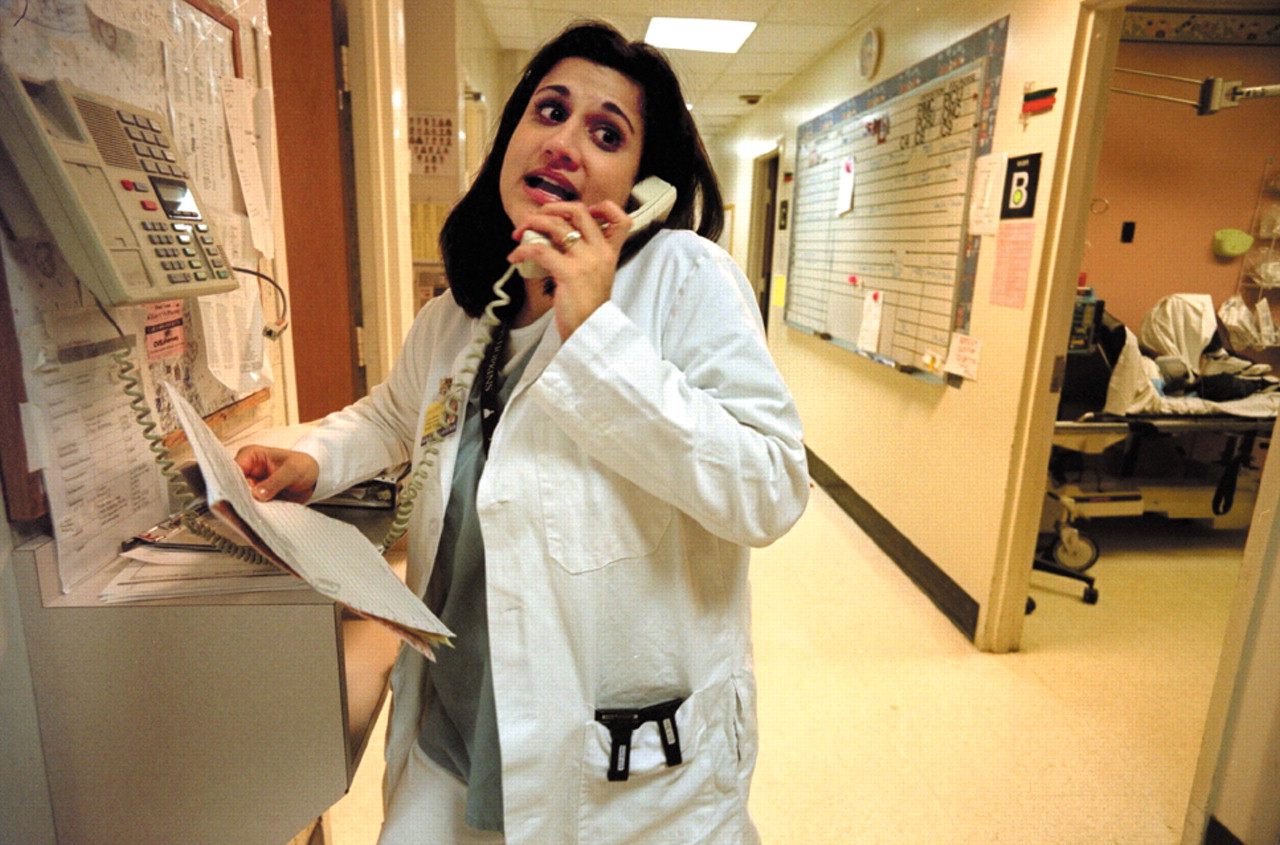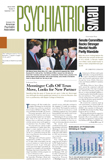Each year, APA bestows an award on a newspaper reporter who has done an outstanding job covering issues in psychiatry. The recipient this year is a soft-spoken reporter from the Baltimore Sun named Diana Sugg.
APA gave her its Robert T. Morse Award for an article titled “A Hospital Crisis: Children in Need of Psychiatric Care.”
Nada Stotland, M.D., speaker of the APA Assembly, was very impressed with Sugg’s efforts. As Stotland told Psychiatric News, “She has done an extraordinary front-page story based on following a child psychiatry fellow at Johns Hopkins throughout emergency calls and putting heart-rending faces” on children who do not get mental health care elsewhere.
How the article came to be, however, is a story in itself. It involved not only Sugg but psychiatrists at Johns Hopkins, and especially the child psychiatry fellow Irm Raja Bellavia, M.D. In a sense, the article was a collaboration between Sugg and Bellavia, and this collaboration affected each of them, both professionally and personally. Here, then, is the story behind the story.
In spring 1999, a Johns Hopkins press-relations representative called Sugg to say that the number of youngsters with mental health problems showing up at the Johns Hopkins Children Center emergency room had increased dramatically since 1995, and that she thought that there might be a news story for Sugg in the increase. “That was it basically, one phone call, saying these kids are flooding the emergency room,” Sugg told Psychiatric News during a phone interview.
At first Sugg thought it would be a straightforward news story—maybe a mental health clinic near Johns Hopkins had closed, leading to an overflow of mental health patients at the Hopkins emergency room. But as she got things underway, she started to suspect that the causes were much more complex. Even more disturbing, she hypothesized, was that what was happening at Hopkins might be occurring in other hospital emergency rooms around the United States. In other words, it was looking as if there might not be enough mental health services for young people, so that they resorted to visiting emergency rooms for their problems.
Sugg was convinced that in order to do justice to this complex subject and give it a human angle, she needed to get inside Hopkins’ emergency room and witness first-hand what was happening.
“But there were two problems,” she explained. “First, we are talking about kids. Secondly, we are talking about psychiatric care. And both are often confidential arenas. So it ended up being a series of meetings between me and some of the psychiatrists who were overseeing the care of these kids in the emergency room, telling them who I was and what I wanted to do. Getting them to trust me. This went on for a few months. It wasn’t like it was every day, but rather a continual push to get into the emergency room. Finally, in fall 1999, they said, ‘Okay, you can go in and follow one of our residents for one night.’ “
That resident was Bellavia. She had just started her fellowship in child and adolescent psychiatry at Hopkins, and her training director asked her if she would be willing to work with Sugg. She said yes.
“At first I was just like anyone would be,” Bellavia said during a phone interview from her home in Charlotte, N.C. “You feel a bit more self-conscious about your abilities and kind of feel that you are being watched. But Diana was so natural and so cooperative, and I was so busy that after a while I sort of forgot that she was there.”
Families’ Response
Tagging along with Bellavia, however, turned out to be more challenging for Sugg. For instance, even though Bellavia would explain to families what Sugg was doing and ask whether it was all right if Sugg sat in during their medical visits, Sugg gathered pretty quickly that many families were in crisis and couldn’t decide at that point whether they wanted to be included in a newspaper article. So Sugg would say to them, “I would like to sit in and take notes and see what’s happening and chat with you, but I guarantee you that none of this is going to be in the paper unless later, when I contact you, you agree to it. In other words, they didn’t have to make a decision that night, but I was still gathering potential information for my article.”
On still other occasions, families would appear to feel comfortable about Sugg sitting in during their medical visits, yet she wasn’t comfortable about it.
For instance, she said, “there was a boy of 13 or so with his mom, and one of the questions was, ‘Are you sexually active?’. And I thought, I don’t think it is right that I am sitting in on this. Yet, on the other hand, I was thinking, I can really help educate the public, get them to understand what these kids are going through, that these [psychiatric disorders] are medical illnesses that can be treated.”
Psychological Toll
Just being in the emergency room with so many mentally ill children and their distressed families took its psychological toll on Sugg. “It was very disturbing to see kids in such pain,” she said. “There was a 3-year-old boy who had tried to kill himself and his younger brother. There was a 14-year-old boy kicking his feet against the exam table, upset about his parents’ divorce. He was kind of shy, looked up at Dr. Bellavia, and asked, ‘Can I just come here once and a while and talk with you?’.”
Nonetheless, Bellavia and Sugg got through their one-night collaboration, and what had started off as just a one-night affair actually turned into a seven-night one. “I had to cover my regular health-and-medicine beat at the Baltimore Sun at the same time,” Sugg explained, “so it would be like one night a week at the emergency room as well. I would just go in there prepared, wearing comfortable clothes, carrying my tape recorder, tapes, water, and crackers. Time was on my side for observing and talking with families because they had to wait so long for their children to receive medical attention.”
Also, as these seven nights went by, Sugg came to better understand psychiatry and to hold psychiatrists in higher esteem. “It gave me an appreciation of how complicated, how deep psychiatry is,” she said. “And Dr. Bellavia was wonderful! She would be so busy sometimes at three in the morning, doing paperwork and trying to get these kids admitted, and I could see that these families were haunting her, too.”
Also, as the seven nights went by, Bellavia came to acquire a better understanding of journalism and to acquire a greater respect for journalists. “Diana would be in the background and sometimes even talk with the families,” Bellavia said. “And sometimes it was helpful to have her there, she is very sensitive.”
Response to Article
But perhaps the biggest rewards accruing from their collaboration emerged after Sugg’s article about it was published on Sunday, February 13, 2000.
On a light note, for example, Bellavia and her husband went out for coffee and donuts in Baltimore that morning, and Bellavia was amazed to find not only Sugg’s article, but a photo of herself on the front page. During the next few days, Bellavia’s colleagues teased her about being a star.
On a more serious note, however, Bellavia said, “I think the article made me more appreciative of the power of the media and how it can impact child psychiatry issues. I was skeptical at first as to how much of my experience with Diana was going to be portrayed as truthfully and as sensitively as I would like. But after seeing the article, I acquired a new respect for journalism and especially for journalists like Diana who write about serious issues that need national attention.
“Local television stations also followed up on the article,” Bellavia continued. “There was discussion about the need for more services for children with mental health issues. I think the article also received national recognition, and that was worthwhile, given that the problem in Baltimore sort of represents a microcosm of the experience in the country.”
And Sugg will never forget the phone call informing her that she had won an APA award for her article. “I had some health problems,” she said, “so when I got the call, it made me feel really good. Also, because top people in the country had looked at my efforts and had judged them as excellent, it helped me believe in myself again.”
So now that all is said and done, would Bellavia once again participate in a similar venture? “Yes, I definitely would,” she said. “If what I do not only helps my patients and their families, but also educates the public about the lack of mental health services for kids or about other child psychiatry problems, yes, I would do it, absolutely!”
And as for Sugg, would she undertake another investigation like the one at Hopkins? The answer is yes. In fact, she is already at work on another child psychiatry piece—this time about depression and suicide in youngsters. “The emergency room story was well-received in the community,” she said. “People found it moving, people thought I got it right, so they are now entrusting me with personal experiences for this article as well.”
Sugg’s award-winning article, “A Hospital Crisis: Children in Need of Psychiatric Care,” can be read on a Baltimore Sun Web site at www/sunspot.net/search for a fee of $1.95. ▪

